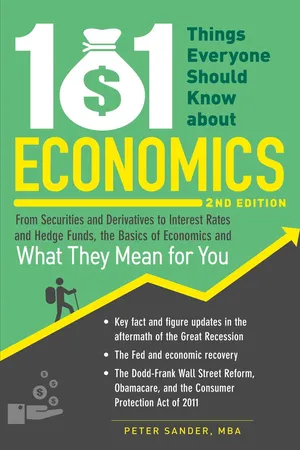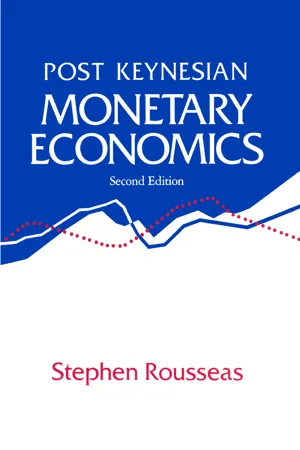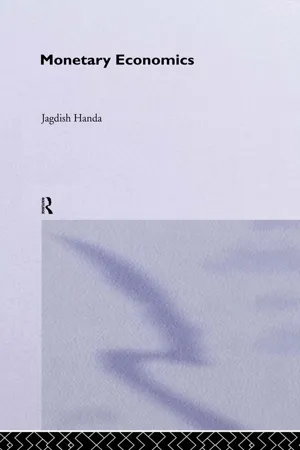Economics
Bank Interest Rates
Bank interest rates refer to the percentage charged or paid by a financial institution on funds held by customers. These rates impact borrowing and saving costs for individuals and businesses, influencing spending and investment decisions. Central banks often use interest rates as a tool to control inflation and stimulate economic growth.
Written by Perlego with AI-assistance
Related key terms
5 Key excerpts on "Bank Interest Rates"
- eBook - ePub
101 Things Everyone Should Know About Economics
From Securities and Derivatives to Interest Rates and Hedge Funds, the Basics of Economics and What They Mean for You
- Peter Sander(Author)
- 2013(Publication Date)
- Adams Media(Publisher)
The good news: the sort of stagflation caused by regulation or economic inefficiencies is less likely to happen in the United States than elsewhere. Despite what it may seem like sometimes, the U.S. economy is considered to have one of the easiest and most consistent regulatory climates of any developed country. This is why many economists are concerned when they hear cries for more regulation, and why they became concerned with some of the proposed policy changes that came with the recent economic crisis—they want to preserve the “stable state” the United States offers for capitalist commerce.21. INTEREST RATES
An interest rate is the price a borrower pays to borrow money. The key word is price —for whatever reason, possibly owing to the negative references to the borrowing and lending of money in the Bible, the concept that interest is a price paid for the use of something, in this case, money, is poorly understood by most. If you think of interest rates as a price, sometimes too high, sometimes a bargain, you’ll learn to make better decisions when evaluating a borrowing opportunity.From your point of view, interest rates are a price, or cost, of using money. They are also the price, or benefit received, for letting someone else use your money, as in when you deposit money in a bank or buy a bond. Finally, on a national scale, interest rates are also a vital tool used by governments to control money supply and the availability of credit, and thus to exert some control over the economy.What You Should Know
Interest rates are normally expressed as a percentage of a borrowed balance over the period of one year. Many interest rates are quoted as a nominal, or ongoing, interest rate, with an “annualized percentage rate” quoted in parallel to account for all borrowing costs, including fees, associated with a borrowing transaction, on an annual basis. Federal law requires publication of APRs to allow simple “apples-to-apples” comparisons of the price to borrow money.The interest rate, or price, for the use of borrowed funds depends on several factors:- Length of loan term. How long will you keep the money you borrow? That will influence the price, because of two things. First is the opportunity foregone by the owner of the money to spend it or invest it in something else. People tend to prefer liquidity
- eBook - ePub
Money and Banking
An International Text
- Robert Eyler(Author)
- 2009(Publication Date)
- Routledge(Publisher)
Something we will explore in depth when we talk about money demand later is the idea of the interest rate as the opportunity cost of having cash in your pocket. This relationship between the quantity of cash or liquidity demanded and the interest rate is of key importance to a great deal of macroeconomic theories but also to monetary and fiscal policy in practice. The way consumers react to changes in interest rates paid on their cash holdings changes the demand for goods and services, as well as the demand for lending. However, for now the idea is simple: the interest rate is the opportunity cost of holding money in your wallet rather than in an interest-bearing account or investment.Measure of time preference
It is this definition that links the three above and binds them in the household’s eyes. When you chose to consume more than your income, or consume with credit rather than paying in full, you are making a choice about your time preference to consume. The interest rate is a measure of how people prefer to consume with respect to time: if the interest rate falls, there will be marginal changes in consumption based on a smaller cost of credit. Certain households which initially would save, say $1000, now spend $100 of that $1000 and save only $900. They still save a certain amount, but it is less. The lower interest rate has triggered an incentive for them to spend on credit, or prefer to spend now than later in time.The cost of borrowing falls in the previous example, providing an incentive to borrow. Certain lenders must provide the loan, thus they see the interest rate as the revenue from lending, and want to take advantage of it. Finally, the borrower must demand cash in order to spend, thus the cost of holding money must also be going down at the same time, and intuitively it does. The interest rate is all four of these ideas simultaneously, and must be for financial markets to work correctly. We will see later that the interest rate’s measure of time preference characteristic makes the entire economy work correctly. - eBook - ePub
- Rousseas(Author)
- 2016(Publication Date)
- Routledge(Publisher)
More generally, what all this adds up to is that the notion of a market-clearing equilibrium "interest" rate—whether in the old "productivity-thrift" theory, or the "bastard" Keynesian IS-LM approach, or a market-determined short-run rate—is a theoretical fiction used to provide determinate theoretical solutions within arcane models bearing no relation to the real world. In the universe of economics, interest rates are not the equilibriating force of textbooks. They are essentially a markup over competitive prime costs in a broadly conceived financial sector that is bound to exhibit an even greater concentration of economic power, especially in the banking industry, as the recent, hasty deregulation of the financial sector leads to an even higher level of bank failures, the forced merger of those that do survive with the giants of the banking industry, and the entry into the banking industry of nontraditional types of institutions. In the meantime, the impact of structurally higher and uncapped interest rates all along the liquidity spectrum on what Keynes called the sector of "Industrial Circulation" will be pronounced since interest rates in their varied manifestations will play an even more significant role than before in determining investment, profits, and the process of capital accumulation and growth in a capitalist society.Notes
1. A Treatise on Money (London: Macmillan, 1930), Vol. 1, p. 243, original italics. Subsequent quotations are from Volume 1, Chapters 3 and 15.2. "The General Theory of Employment," Quarterly Journal of Economics, February 1937, "Alternative Theories of the Rate of Interest," Economic Journal, June 1937, and "The 'Ex Ante' Theory of the Rate of Interest," Economic Journal, December 1937.3. Although the basic equations are taken from Davidson's Money and the Real World, Chapter 7, they have been significantly altered and the model as a whole is sharply and substantively different from that of Davidson.4. See especially, J. A. Kregel, "Constraints on the Expansion of Output and Employment: Real or Monetary?" Journal of Post Keynesian Economics , Winter 1984-85.5. See Hyman P. Minsky, John Maynard Keynes (New York: Columbia University Press, 1975), Chs. 2 and 3.6. Michal Kalecki, Selected Essays on the Dynamics of the Capitalist Economy, 1939–1970 (New York: Cambridge University Press, 1971), Ch. 5.7. Paul Meek, U.S. Monetary Policy and Financial Markets - eBook - ePub
- Jagdish Handa(Author)
- 2002(Publication Date)
- Routledge(Publisher)
part sevenTHE RATES OF INTEREST IN THE ECONOMYPassage contains an image
chaptertwentyTHE MACROECONOMIC THEORY OF THE RATE OF INTERESTThe rate of interest is one of the endogenous variables in the Keynesian and classical models, so that its analysis is properly conducted as part of a complete version of those models. These were presented in Chapters 13 and 14.This chapter singles out the competing views on the determination of the rate of interest and focuses on their differences and validity. It also highlights the very important difference between the comparative static and the dynamic determination of the rate of interest.key concepts introduced in this chapter
• The Fisher equation of the nominal rate of interest• Stocks versus flows of funds• The loanable funds theory• The liquidity preference theory• The excess demand function for bonds• The dynamics of interest rate determination• The neutrality of money and inflation for the real rate of interestMacroeconomics avoids the bewildering array of interest rates on the numerous assets in the market by focusing on one single rate of interest, without completely specifying which rate of interest it is, as for example in the IS-LM model of Chapters 13 and 14 - eBook - ePub
- W. Charles Sawyer, Richard L. Sprinkle(Authors)
- 2020(Publication Date)
- Routledge(Publisher)
The effect of changes in the money supply on the equilibrium rate of interest is illustrated in Figure 15.6. Let us assume that the money market has an initial equilibrium at point E, with an equilibrium interest rate of i. If the money supply increases from MS to MS 1 with an unchanged demand for money, the new equilibrium in the money market is at F and the rate of interest declines to i 1. On the other hand, if the central bank decreases the money supply from MS to MS 2, the new equilibrium in the money market would be at G and the rate of interest would rise to i 2. 7 FIGURE 15.6 Shifts in the supply of money and the equilibrium interest rate As Figure 15.6 indicates, changes in the money supply have an obvious impact on an economy’s interest rate. If the central bank changes the money supply for any reason, interest rates also will change. Given a stable money demand, a higher money supply implies lower interest rates. Analogously, a lower money supply usually will mean higher interest rates. As we indicated earlier, in developed countries changes in the money supply usually are accomplished using open market operations. The central bank buys bonds to increase the money supply and sells bonds to reduce it. In both cases, the central bank can alter the money supply and, therefore, interest rates. 8 As we will see in the next section, changes in the equilibrium interest rate usually translate into changes in the country’s exchange rate. THE INTEREST RATE AND THE EXCHANGE RATE IN THE SHORT RUN With our understanding of how interest rates are determined, we can now examine the relationship between interest rates and the exchange rate in the short run. This relationship is known as interest arbitrage. The relationship between these two rates hinges on the existence of international markets in which short-term capital can flow unimpeded between countries. To explain interest arbitrage, let us suppose that you are the chief financial officer (CFO) for a large U.S
Learn about this page
Index pages curate the most relevant extracts from our library of academic textbooks. They’ve been created using an in-house natural language model (NLM), each adding context and meaning to key research topics.




